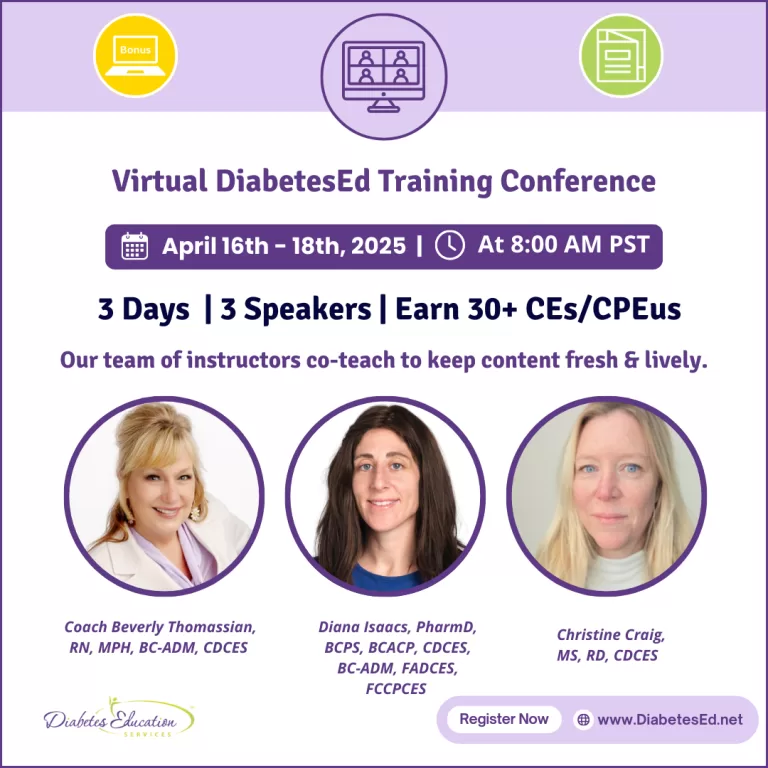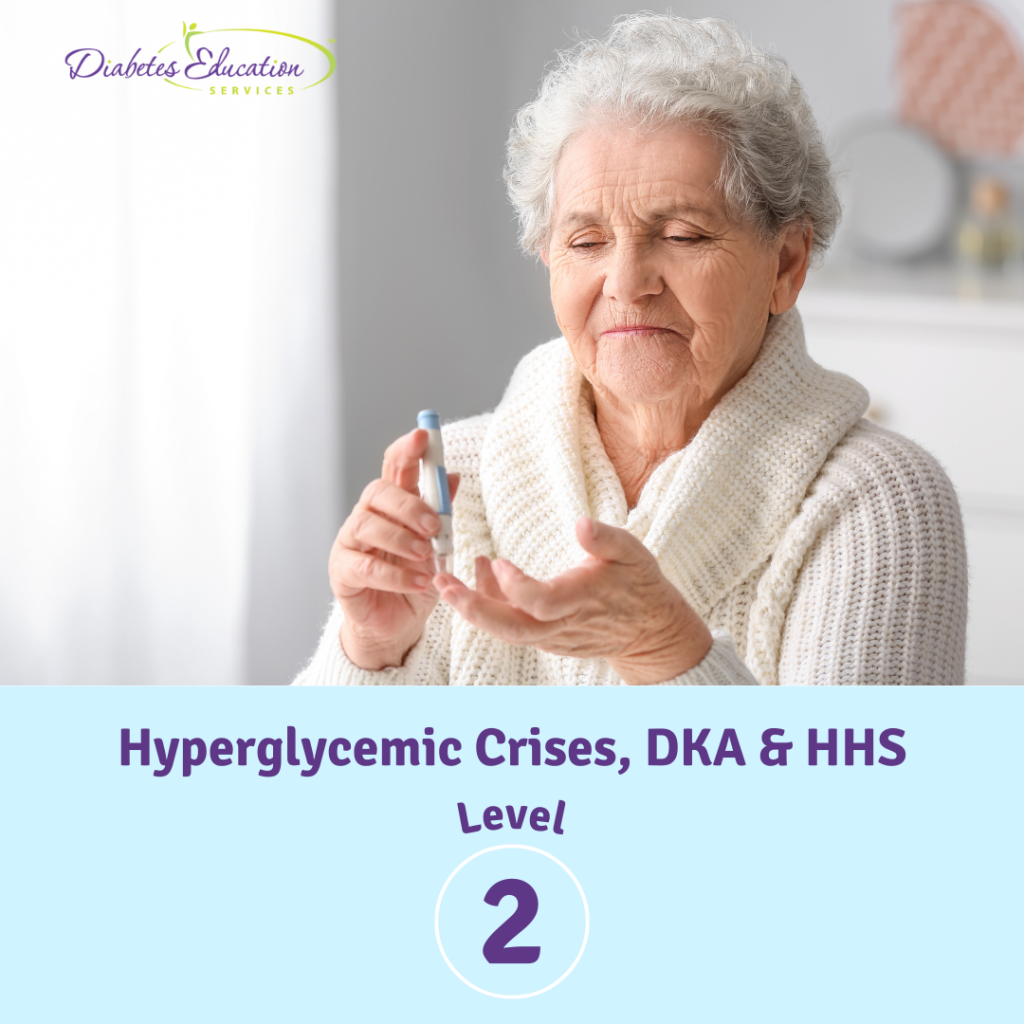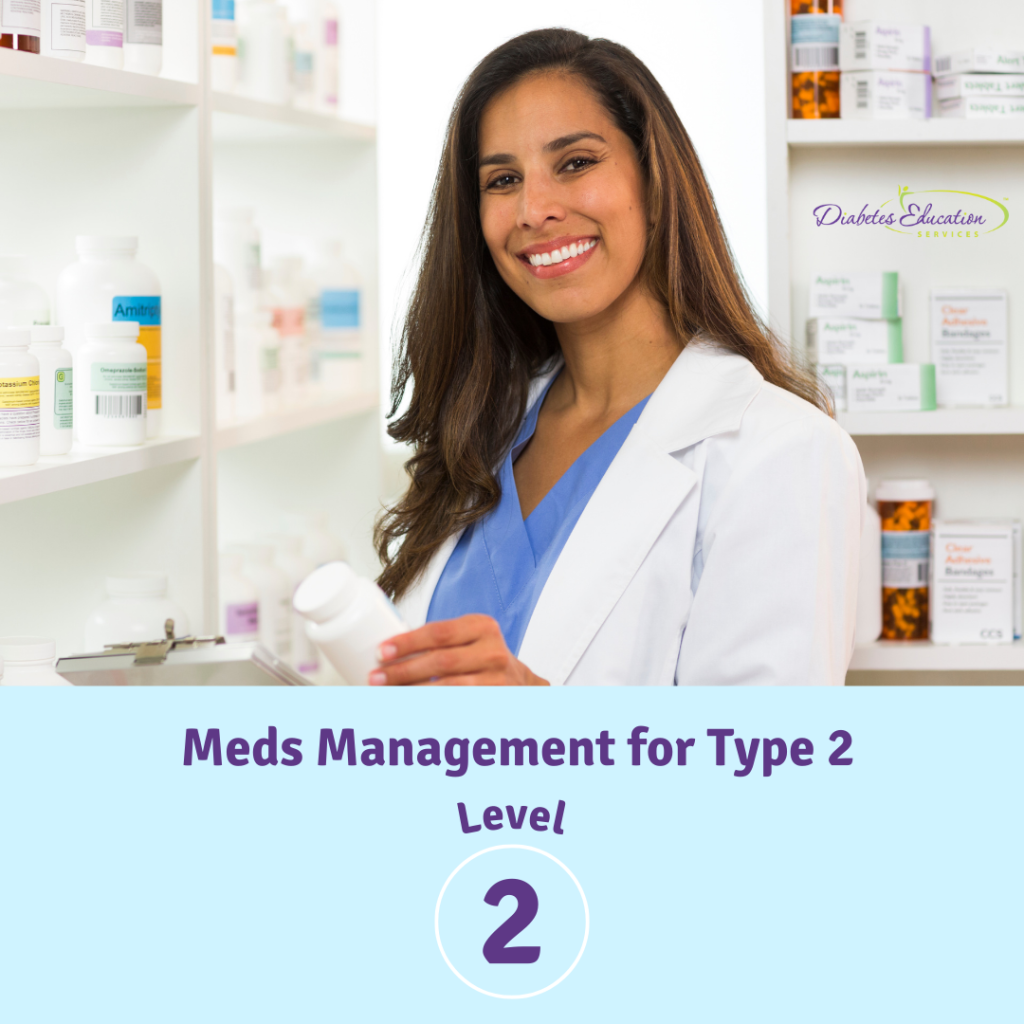
Ready to get certified?
Free CDCES Coach App

Subscribe
eNewsletter
Download
Free Med Pocket Cards
Nobel 2024 – Implications for T1D and Celiac Disease
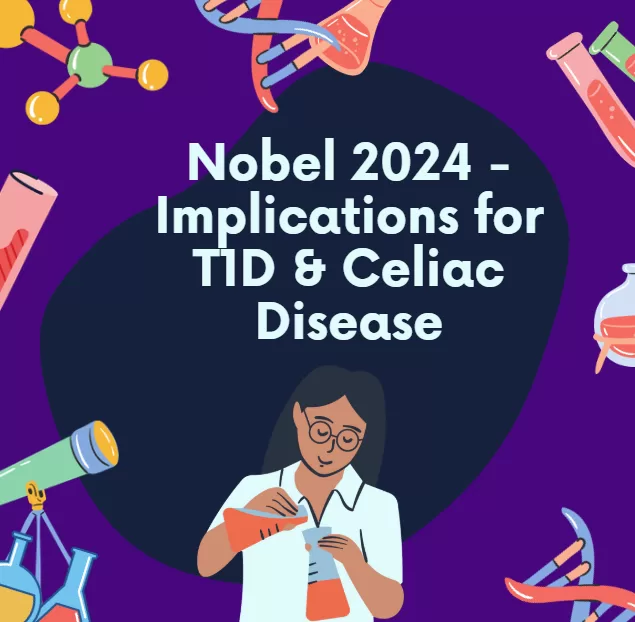 by Christine Craig, MS, RD, CDCES
by Christine Craig, MS, RD, CDCES
Type 1 diabetes and celiac disease share a fascinating connection rooted in their autoimmune nature and shared genetic background.
In T1D, autoantibodies attack the insulin-producing beta cells of the pancreas, leading to insulin deficiency. In celiac disease, ingesting gluten triggers an immune response that damages the epithelial villi of the small intestine. Recent studies suggest that approximately 6% of individuals with T1D also have celiac disease, far higher than the prevalence of celiac disease in the general population, which is around 1%.
Shared Genetic Background
T1D and celiac disease have a shared genetic background, with 95% of individuals with type 1 and 99% of individuals with celiac having the presence of HLA class II genes as DQ2 and DQ8.1 While the presence of these DQ and other alleles increases the risk of developing T1D by 30–50%, most individuals with these genetic predispositions will never progress to develop either condition, this highlights the need for deeper insights into the factors predict that disease onset and progression.
Nobel Prize Awarded
In October 2024, the Nobel Prize in Physiology or Medicine was awarded to Victor Ambros and Gary Ruvkun for discovering microRNA and its role in post-transcriptional gene regulation.2 As we recall, messenger RNA is created by copying a gene sequence from DNA, carrying this genetic code to the ribosomes for protein synthesis- microRNAs up or down-regulate and “fine-tune” gene expression.2 MicroRNAs could be utilized to track what genes are expressed and in which cells. They could potentially be used as a tool for early detection and biomarkers of disease progression.
In T1D genetic risk combined with a triggering event leads to expression of autoantibodies. BreakthoughT1, previously JDRF,3 funded additional research on microRNA due to the potential to increase early prediction of T1D autoimmunity, provide additional biomarkers of Stage 1 and Stage 2 T1D progression, and for its potential to modulate the immune system by slowing down or ceasing autoimmune response. In celiac disease, tissue transglutaminase (TGA) and anti-endomysium autoantibody concentrations are used to screen individuals at risk of celiac disease, however these autoantibodies are often elevated when villous atrophy is already present. An article by Tan and colleagues4 reviewed 53 microRNAs as potential biomarkers of celiac disease, some were found more than a year before tissue transglutaminase (TGA) positivity, and some became normalized with initiation of a gluten-free diet.
microRNA enable earlier detection?
microRNA has the potential for early detection before the onset of intestinal damage. In both celiac disease and T1D, we currently use autoantibodies as predictors of disease development, but it is the biopsy of the villi4 or glucose levels that truly diagnose the stage of the disease. microRNAs may enable earlier detection of disease progression before significant damage occurs, revolutionizing current diagnostic and monitoring approaches.
AI to Develop Proteins to Treat Disease?
Another 2024 Nobel Prize awarded in Chemistry, also has implications for T1D and celiac research. David Baker, Demis Hassabis, and John Jumper received their prize for using artificial intelligence (AI) to develop computational protein design and predict protein structure.2 Their research led to the development of a new way to create proteins that have the potential to treat disease, make vaccines, and, important to T1D, develop new glucose-responsive insulins. These glucose-responsive insulins are currently in clinical trials and can activate in response to glucose needs after injection.5 In addition, their research led to the development of TAK-062, an investigational treatment aimed at improving gluten tolerance in individuals with celiac disease.6 TAK-062 holds promise as a therapeutic option to ease the burden of a strict gluten-free diet, which is currently the only treatment for celiac disease.
New Scientific Developments to Provide Future Benefits
Science continues to pave the way for new targeted therapies, and the 2024 Nobel Prizes highlight the breakthroughs which can benefit individuals with autoimmune conditions such as T1D and celiac diseases. The discoveries in protein design and microRNA regulation show promise for additional tools for prediction, early detection, and targeted therapies. Until then, nutrition therapy, diabetes education and a comprehensive team-based care approach remain the cornerstone of managing these complex conditions. If you’re interested in learning more check out all of the Nobel Prize winners here.
References
- Flores Monar GV, et al. Association Between Type 1 Diabetes Mellitus and Celiac Disease: Autoimmune Disorders with a Shared Genetic Background. Cureus. 2022 Mar 7;14(3):e22912.
- Nobel Prize Committee. (2024). Press Release: Retrieved from www.nobelprize.org
- Breakthrough T1D and the Nobel Prizes: Connected!. Downloaded on November 17th, 2024.
- Tan IL, et al. Circulating miRNAs as Potential Biomarkers for Celiac Disease Development. Front Immunol. 2021 Dec 7;12:734763.
- Yun Liu, Shiqi Wang, Zejun Wang, Jicheng Yu, Jinqiang Wang, John B. Buse, Zhen Gu; Recent Progress in Glucose-Responsive Insulin. 20 August 2024; 73 (9): 1377–1388.
- The 2024 Nobel Prize in Chemistry goes to a leading celiac researcher. Downloaded on November 18, 2024.
Want to hear more from this expert?
Join our upcoming Virtual Conference!!
Join Coach Beverly and Team for two and a half days of knowledge-sharing, fun, and “aha” moments for our Virtual DiabetesEd Training Conference.
Attendees will leave this conference with new tools and a refreshed understanding of the latest advances in person-centered diabetes care. Our team highlights the ADA Standards of Care, medications, behavior change, technology, medical nutrition therapy, and more!
Our instructors co-teach the content to keep things fresh and lively.
Sign up for Diabetes Blog Bytes – we post weekly Blog Bytes that are informative and FREE! Every week we post one exam practice Question of the Week and Rationale of the Week. Sign up below!
Recent Blog Bytes
- Question of the Week | CS’s A1C Climbs After Experiencing Distress
- Keeping You in the Loop: twiist Insulin Pump
- Question of the Week | What Do New ADA Standards Say About Development of Type 2?
- Rationale of the Week | What Year ADA Standards Should JR Study?
- New CDCES Coach App – Download Yours Today!
The use of DES products does not guarantee the successful passage of the certification exam. CBDCE and ADCES do not endorse any preparatory or review materials for the CDCES or BC-ADM exams, except for those published by CBDCE & ADCES.
How Healthcare Professionals Can Earn CDCES Certification Hours
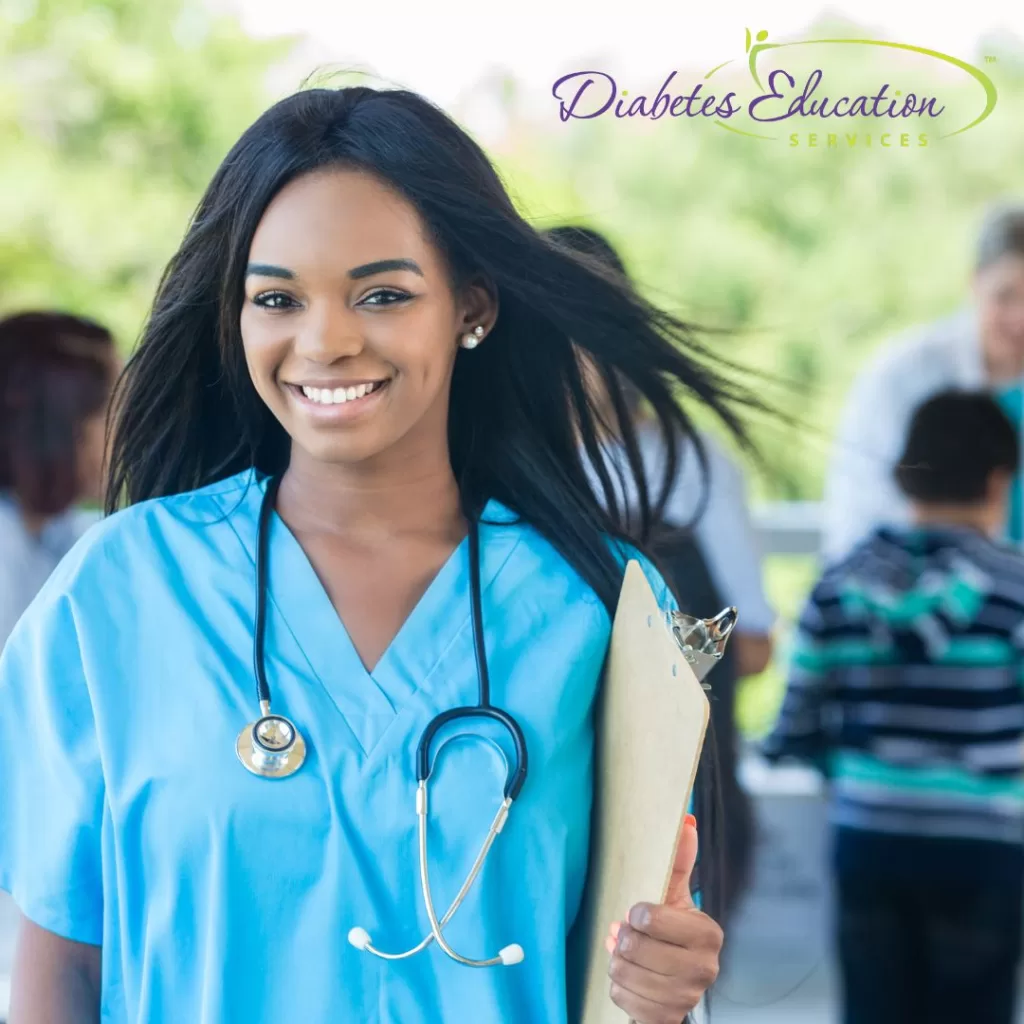
Becoming a Certified Diabetes Care and Education Specialist (CDCES) is an incredible achievement that not only demonstrates your expertise but also reflects your unwavering commitment to improving the lives of individuals with diabetes.
Whether you’re already on this path or just considering it, the fact that you are exploring the certification process shows your dedication to expanding your knowledge and enhancing the care you provide to individual with diabetes. Achieving this certification allows you to make an even greater impact in the field of diabetes care and education, empowering those with diabetes to live healthier, more fulfilling lives.
If you are just getting started, you may be wondering what counts toward the 1000 hours of Diabetes Self Management (DSME) Experience.
Below is an excerpt from the CBDCE Exam Handbook regarding what hours count towards this 1000-hour DSME requirement:
- Assessment: The participant’s DCE needs are identified. This process is led by the participant with the assessment and support of the educator.
- Education and Care Plan: The participant’s individualized education and care plan is developed. The plan reflects the participant’s self-management goals and current evidence and practice guidelines and includes criteria for evaluating outcomes.
- Interventions: The specialist delivers intervention options to assist the participant in meeting self-management goals.
- Ongoing Support: The specialist provides options for ongoing support and resources. The support option(s) is selected by the participant to best meet their self-management goals.
- Participant Progress: The specialist will monitor and communicate whether the participant is achieving their self-management goals and other outcome(s) to evaluate the effectiveness of interventions. Additional assessments are based on the participant’s needs across the lifespan.
- Documentation: The specialist documents the assessment, education plan, intervention, and outcomes in the participant’s health record.
- Services Development/Administration: Development and administrative activities performed as part of DSMES services.
How Do I Track My Hours?
Tracking your activities and hours consistently is key, and these varied approaches can help you meet the requirements while making a positive impact in the community.
To log your hours we created the Diabetes Management Hours Tracker. The column “Remaining Hours Needed” is a formula that is tied to “Hours Completed” so be sure to only put numbers in the hour’s column so the formula automatically deducts those hours to get the remaining hours you need.
Work Experience Hours: How To Gain Hands-On Experience
Meeting the 1,000-hour requirement for the Certified Diabetes Care and Education Specialist (CDCES) exam is achievable with a variety of approaches. The hours needed can include volunteer or paid hours. Below are some practical ways to accumulate hours if you are not able to accrue enough hours in your current work environment.
- Volunteer in Community Health Programs or Diabetes Camps
- Offer your expertise to local diabetes prevention or management programs, such as YMCA’s Diabetes Prevention Program, Diabetes Camps, or similar initiatives.
- Shadow a Diabetes Education Specialist in your Community
- Search for already existing diabetes programs in your community and volunteer to help with their diabetes program. This might even evolve into a paid position in the future.
- Join ADCES Local Networking Diabetes Groups
- Networking with diabetes educators in your area can lead to opportunities to gain hours and possible future employment.
- Join Diabetes Support Groups
- Facilitate or assist with support groups in person or online to provide guidance and share educational resources.
- Offer Educational Workshops or Webinars
- Create and present workshops for people with diabetes or even train other healthcare professionals about aspects of diabetes management.
- Collaborate with Pharmacies
- Partner with local pharmacies to provide diabetes education to people picking up diabetes-related medications or supplies.
- Participate in Health Screenings or Free Health Clinics
- Assist with diabetes screenings, provide educational coaching at health fairs, or sign up to provide diabetes coaching at your local free clinic.
- Support Long-Term Care Facilities
- Offer diabetes-related education to staff and residents in long-term care or assisted living facilities.
- Write or Develop Educational Content
- If you’re skilled in writing, contribute to diabetes educational materials for local papers and websites. You can count the time spent on research and content development towards your hours.
- Join our Facebook Certification Exam Study Group
- This group is great for networking, connecting with colleagues and sharing study tips.
Conclusion: You’ve Got This!
The road to becoming or renewing your CDCES certification may feel like a big task, but remember—you’re not alone in this journey. You’re part of a supportive community of healthcare professionals dedicated to improving diabetes care. By earning the required hours through work experience, and volunteer opportunities, you’ll build the skills and knowledge needed to pass the exam and make a lasting impact in the field of diabetes care.
You’ve already made the commitment to be the best diabetes care provider you can be. Keep going—you’re doing amazing things, and we’re here to support you along the way. If you need guidance or resources to get started, check out DiabetesEd.net for accredited courses, webinars, and study materials designed to help you succeed! We are excited to welcome you to this diabetes education community and hope you find this information helpful!
Need CE’s to fullfil the CDCES Exam Requirement?
Check out our most popular bundle the CDCES Deluxe Prep!
Get ready for the CDCES exam with our comprehensive online prep bundles, designed for healthcare professionals like you!
Choose the Perfect Bundle for You:
CDCES Boot Camp | Basic Exam Prep: Ideal for those looking for all-in-one access to Levels 1, 2, and 3, Toolkits, 30+ courses, 50 CEs/CPEUs, and 400+ practice questions.
CDCES Boot Camp | e-Deluxe Exam Prep: Includes everything in the Basic Bundle, plus the ADCES Certification Review Guide with 400+ additional practice questions.
Start your journey to CDCES success today!
Sign up for Diabetes Blog Bytes – we post weekly Blog Bytes that are informative and FREE! Every week we post one exam practice Question of the Week and Rationale of the Week. Sign up below!
Recent Blog Bytes
- Question of the Week | CS’s A1C Climbs After Experiencing Distress
- Keeping You in the Loop: twiist Insulin Pump
- Question of the Week | What Do New ADA Standards Say About Development of Type 2?
- Rationale of the Week | What Year ADA Standards Should JR Study?
- New CDCES Coach App – Download Yours Today!
The use of DES products does not guarantee the successful passage of the certification exam. CBDCE and ADCES do not endorse any preparatory or review materials for the CDCES or BC-ADM exams, except for those published by CBDCE & ADCES.
Question of the Week | Which precaution when starting tirzepitide according to 2025 ADA Standards?
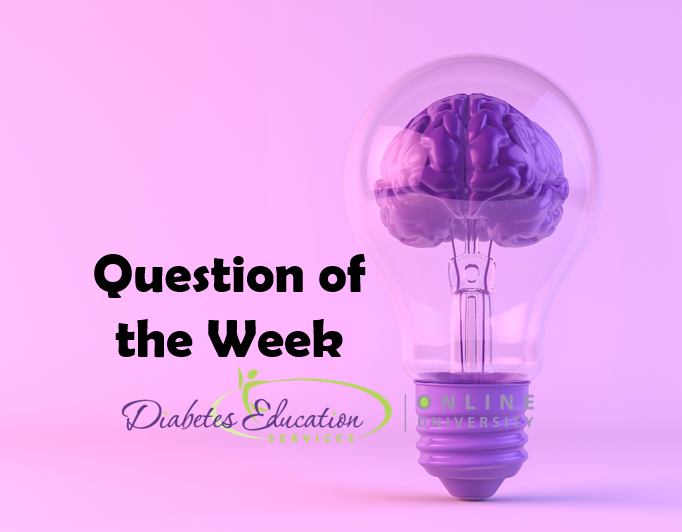
TZ is a 32-year-old female with type 2 diabetes and an A1C of 8.3% who takes metformin 1000mg twice daily and is on oral contraception. TZ is going to start tirzepitide 2.5mg weekly to help with weight loss and blood glucose management. According to the 2025 ADA Standards, what precaution would we recommend to TZ along with the initiation of tirzepitide?
According to the 2025 ADA Standards, what precaution would we recommend to TZ along with the initiation of tirzepitide?
- Reduce the metformin by 50% to prevent side effects and maintain B12 levels.
- Assess TZ’s risk of acidosis before initiating dual therapies.
- Provide a glucagon emergency kit in case of severe hypoglycemia.
- Suggest using a second form of contraception for at least 4 weeks.
Want to learn more about this question?
Join us live starting Jan. 8th @ 11:30am PST
Level 1 Diabetes Fundamentals
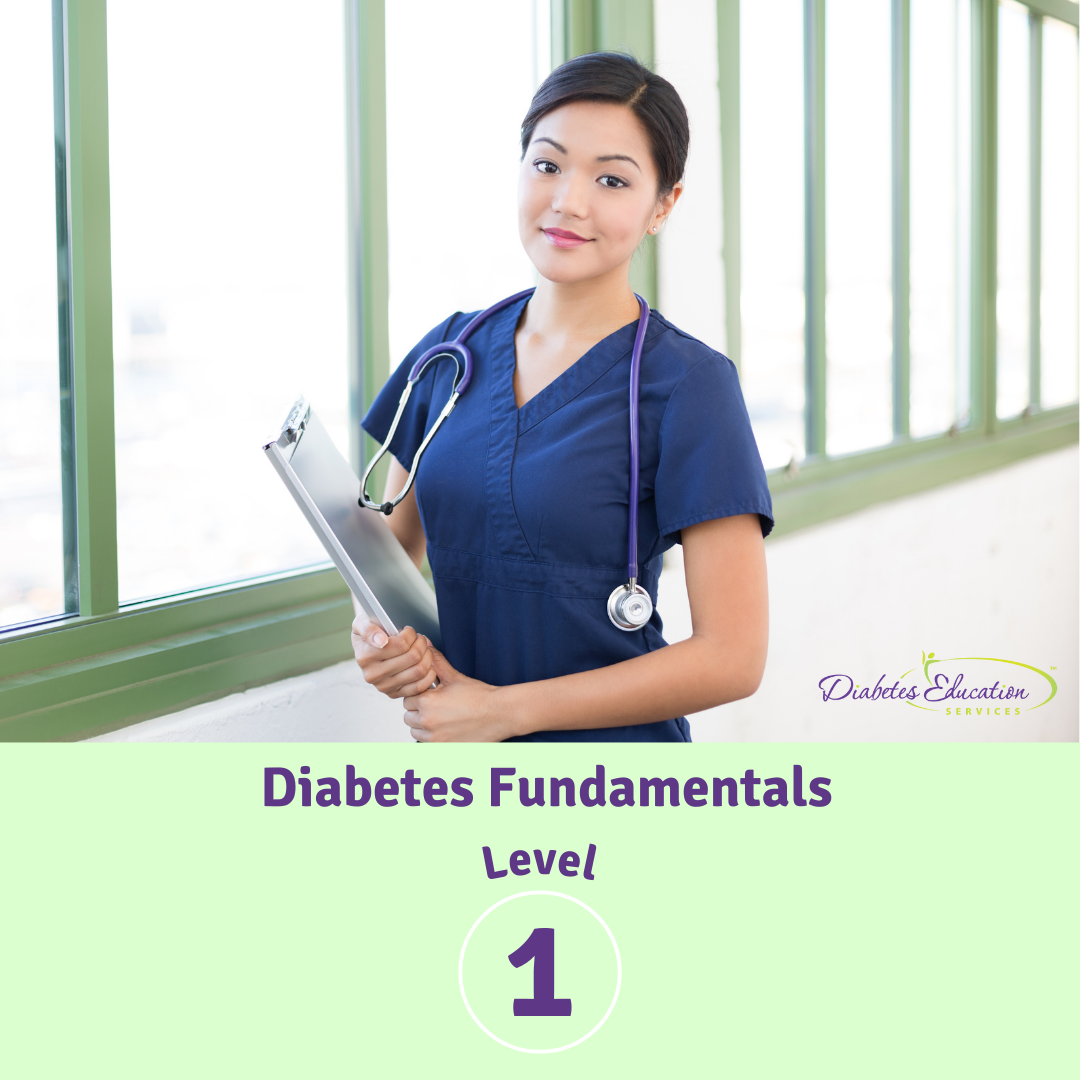
This bundle is specifically designed for healthcare professionals who want to learn more about diabetes fundamentals for their clinical practice or for those who are studying for the Certified Diabetes Care and Education Specialist (CDCES) exam.
All hours earned count toward your CDCES Accreditation Information
Sign up for Diabetes Blog Bytes – we post weekly Blog Bytes that are informative and FREE! Every week we post one exam practice Question of the Week and Rationale of the Week. Sign up below!
Recent Blog Bytes
- Question of the Week | CS’s A1C Climbs After Experiencing Distress
- Keeping You in the Loop: twiist Insulin Pump
- Question of the Week | What Do New ADA Standards Say About Development of Type 2?
- Rationale of the Week | What Year ADA Standards Should JR Study?
- New CDCES Coach App – Download Yours Today!
The use of DES products does not guarantee the successful passage of the certification exam. CBDCE and ADCES do not endorse any preparatory or review materials for the CDCES or BC-ADM exams, except for those published by CBDCE & ADCES.
Rationale of the Week | Best Meds to Treat MASH – 2025 Standards
For last week’s practice question, we quizzed participants on best meds to treat MASH. 64% of respondents chose the best answer. We want to clarify and share this important information, so you can pass it on to people living with diabetes and your colleagues, plus prepare for exam success!
Before we start though, if you don’t want any spoilers and haven’t tried the question yet, you can answer it below: Answer Question
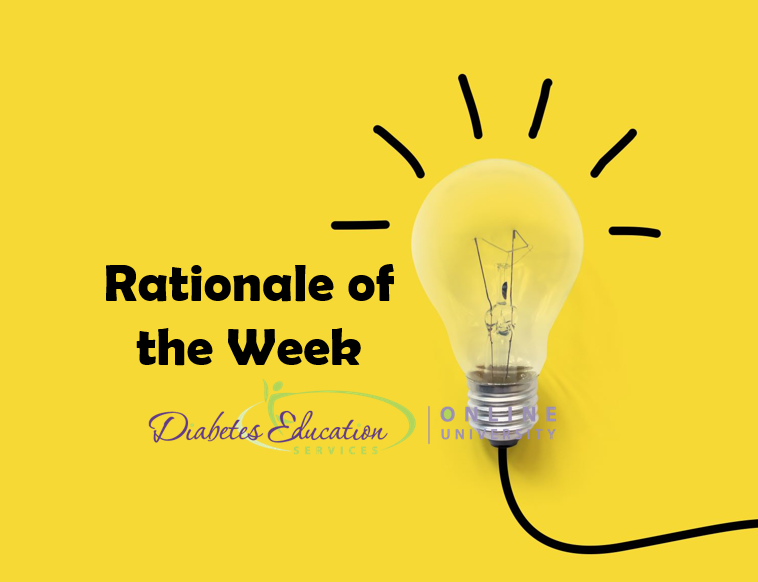
Question: In the 2025 ADA Standards, they have updated the term Non-Alcoholic Steatohepatitis (NASH) to Metabolic Associated Steatohepatitis (MASH). They also recommend pharmacologic agents along with lifestyle interventions to treat people with diabetes and MASH.
Which of the following are the recommended diabetes medications to treat MASH?
Answer Choices:
- Vitamin E and SGLT-2
- Pioglitazone and/or GLP-1 RA / GIP
- Fish oil supplements and statin
- Metformin and/or bolus insulin therapy
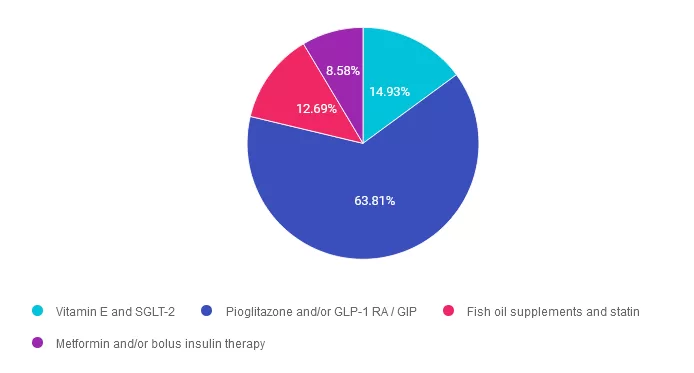
Getting to the Best Answer
Answer 1 is incorrect. 14.93% chose this answer. “Vitamin E and SGLT-2.” While SGLT-2’s will help lower glucose levels and may result in some weight loss, the ADA does not recognize it as a treatment for steatosis. As far as Vitamin E, according to the ADA 2025 Standards, “it may be beneficial for the treatment of MASH in people without diabetes. However, in people with type 2 diabetes, vitamin E monotherapy was found to be ineffective in a small RCT, and it did not seem to enhance pioglitazone’s efficacy when used in combination, as reported in an earlier trial in this population.
Answer 2 is correct. 63.81% of you chose this answer. “Pioglitazone and/or GLP-1 RA / GIP.” GREAT JOB, this is the best answer. According to the ADA Standards In adults with type 2 diabetes with biopsy-proven MASH or those at high risk for liver fibrosis (based on noninvasive tests), pioglitazone, a GLP-1 RA, or a dual GIP and GLP-1 RA is preferred for glycemic management because of potential beneficial effects on MASH.
Answer 3 is incorrect. About 12.69% of respondents chose this. “Fish oil supplements and statin.” Part of this answer is correct. Based on the 2025 ADA Standards, “Statin therapy is safe in adults with type 2 diabetes and compensated cirrhosis from MASLD and should be initiated or continued for cardiovascular risk reduction as clinically indicated. In people with decompensated cirrhosis, statin therapy should be used with caution, and close monitoring is needed, given limited safety and efficacy data. However, the ADA does not recommend fish oil supplements to treat MASH.
Finally, Answer 4 is incorrect. 8.58% chose this answer. “Metformin and/or bolus insulin therapy.” Although metformin therapy and insulin are effective at addressing insulin resistance and lower glucose levels, they are not first line recommended agents to treat MASH.
We hope you appreciate this week’s rationale! Thank you so much for taking the time to answer our Question of the Week and participate in this fun learning activity!
Want to learn more about this question?
Join us for this upcoming webinar!
Test Taking Practice Exam Toolkit
Jan. 13th @ 11:30am PST

You are invited to join Coach Beverly for this FREE Webinar. And, if you want to have access to an additional 220+ sample practice online questions, you can purchase the complete Test Taking Toolkit.
For many of us, taking the certification exam is a nerve-wracking process
During this webinar, Coach Beverly will help you transform your nervousness into focused energy that will help you succeed. She will provide test-taking tips based on her experience taking the certification exam six times.
All hours earned count toward your CDCES Accreditation Information
Sign up for Diabetes Blog Bytes – we post weekly Blog Bytes that are informative and FREE! Every week we post one exam practice Question of the Week and Rationale of the Week. Sign up below!
Recent Blog Bytes
- Question of the Week | CS’s A1C Climbs After Experiencing Distress
- Keeping You in the Loop: twiist Insulin Pump
- Question of the Week | What Do New ADA Standards Say About Development of Type 2?
- Rationale of the Week | What Year ADA Standards Should JR Study?
- New CDCES Coach App – Download Yours Today!
The use of DES products does not guarantee the successful passage of the certification exam. CBDCE and ADCES do not endorse any preparatory or review materials for the CDCES or BC-ADM exams, except for those published by CBDCE & ADCES.
Rationale of the Week | What do the NEW 2025 ADA Standards Say?
For last week’s practice question, we quizzed participants on 2025 ADA Standards & hyperglycemic crises. 43% of respondents chose the best answer. We want to clarify and share this important information, so you can pass it on to people living with diabetes and your colleagues, plus prepare for exam success!
Before we start though, if you don’t want any spoilers and haven’t tried the question yet, you can answer it below: Answer Question

Question: What do the NEW 2025 ADA Standards Say?
According to the Newly Published 2025 Standards of Care, which of the following statements reflect the latest guidelines to treat hyperglycemic crises?
Answer Choices:
- Administer low dose basal insulin analog in addition to intravenous insulin infusion to improve glucose management.
- If serum pH is below 7.4, administer IV bicarb, along with a glucose infusion to resolve severe acidosis.
- To differentiate between DKA and HHS, the most important lab indicators are the anion gap and glucose levels.
- Lactated Ringers is now the preferred intravenous solution for fluid resuscitation.

Getting to the Best Answer
Answer 1 is correct. 43.04% chose this answer. “Administer low dose basal insulin analog in addition to intravenous insulin infusion to improve glucose management.” YES, great job, this is the best answer. According to ADA Standard 16 on Hospital Care, “Studies have reported that the administration of a low dose of basal insulin analog in addition to intravenous insulin infusion may prevent rebound hyperglycemia without increased risk of hypoglycemia.”
Answer 2 is incorrect. 19.59% of you chose this answer. “If serum pH is below 7.4, administer IV bicarb, along with a glucose infusion to resolve severe acidosis.” Since this pH is in the normal range, this person is not in ketoacidosis. According to ADA Standard 16 on Hospital Care, “Several studies have shown that the use of bicarbonate in people with DKA made no difference in the resolution of acidosis or time to discharge, and its use is generally not recommended.”
Answer 3 is incorrect. About 20.10% of respondents chose this. “To differentiate between DKA and HHS, the most important lab indicators are the anion gap and glucose levels.” According to the 2024 Consensus Statement, to differentiate between the two conditions, the most decisive lab indicators are beta hydroxybutyrate or urine ketones to verify insulin deficiency along with pH levels to verify acidosis and osmolality to determine hydration status in HHS.
Finally, Answer 4 is incorrect. 17.27% chose this answer. “Lactated Ringers is now the preferred intravenous solution for fluid resuscitation.” According to the 2024 Consensus Statement, Normal saline or Ringer’s lactate are both accepted IV rehydration solutions.
You are invited to register for our Hyperglycemic Crises – New criteria and treatment guidelines for DKA, Euglycemic DKA and HHS | 1.25 CE – Recorded and Ready for Viewing.
We hope you appreciate this week’s rationale! Thank you so much for taking the time to answer our Question of the Week and participate in this fun learning activity!
Want to learn more about this question?
Join us live on Jan 30, 2025 for our
ADA Standards of Care
Level 2 | Standards of Care Intensive
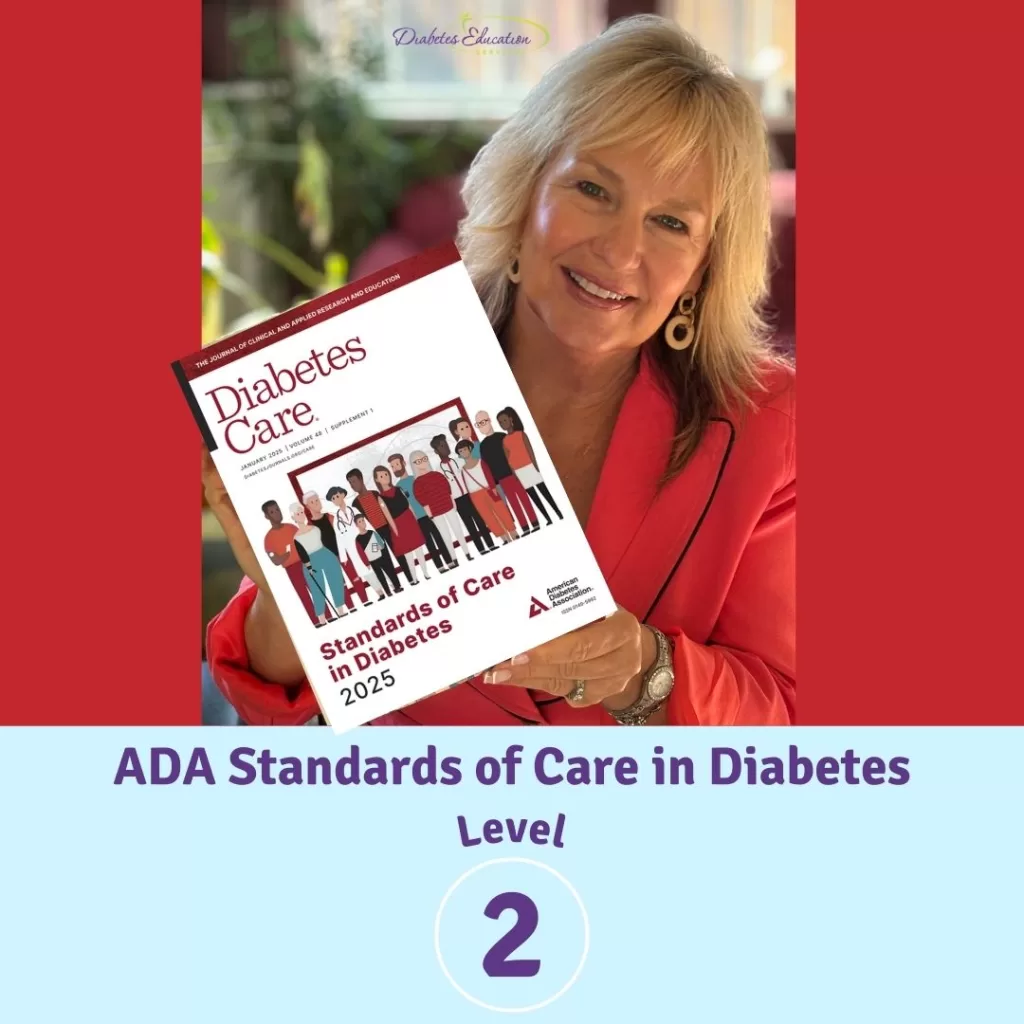
This course, updated annually, is an essential review for anyone in the field of diabetes. Join Coach Beverly as she summarizes the annual updates to the American Diabetes Association’s (ADA) Standard of Medical Care in Diabetes & provides critical teaching points & content for healthcare professionals involved in diabetes care & education.
Objectives:
- A review of changes & updates to the annual ADA Standards of Medical Care in Diabetes.
- Identification of key elements of the position statement.
- Discussion of how diabetes educators can apply this information in their clinical setting.
Learning Outcome: Participants will identify updates and articulate recommendations from the 2024 ADA Standards of Care that can be applied to their practice.
Target Audience: This course is a knowledge-based activity designed for individuals or groups of diabetes professionals, including RNs, RDs/RDNs, Pharmacists, Nurse Practitioners, Clinical Nurse Specialists, Physician Assistants, and other healthcare providers interested in staying up to date on current practices of care for people with prediabetes, diabetes, and other related conditions. The practice areas for RDs/RDNs for CDR reporting are healthcare, preventative care, wellness, and, lifestyle along with, education and research.
Why Attend These Webinars?
- Accessible learning: All webinars are available online, so you can attend from the comfort of your home or office.
- Expert-led: Presentations are led by experienced diabetes educators, healthcare professionals, and researchers.
- Practical advice: Each session is designed to give you actionable strategies that can be applied in your daily life or practice.
- Up-to-date information: Stay informed about the latest research, guidelines, and technology in diabetes care.
How to Register?
Register above or simply visit our website.
For more information or any questions, please email [email protected].
All hours earned count toward your CDCES Accreditation Information
Sign up for Diabetes Blog Bytes – we post weekly Blog Bytes that are informative and FREE! Every week we post one exam practice Question of the Week and Rationale of the Week. Sign up below!
Recent Blog Bytes
- Question of the Week | CS’s A1C Climbs After Experiencing Distress
- Keeping You in the Loop: twiist Insulin Pump
- Question of the Week | What Do New ADA Standards Say About Development of Type 2?
- Rationale of the Week | What Year ADA Standards Should JR Study?
- New CDCES Coach App – Download Yours Today!
The use of DES products does not guarantee the successful passage of the certification exam. CBDCE and ADCES do not endorse any preparatory or review materials for the CDCES or BC-ADM exams, except for those published by CBDCE & ADCES.
Question of the Week | Best Meds to Treat MASH – 2025 Standards

In the 2025 ADA Standards, they have updated the term Non-Alcoholic Steatohepatitis (NASH) to Metabolic Associated Steatohepatitis (MASH). They also recommend pharmacologic agents along with lifestyle interventions to treat people with diabetes and MASH.
Which of the following are the recommended diabetes medications to treat MASH?
- Vitamin E and SGLT-2
- Pioglitazone and/or GLP-1 RA / GIP
- Fish oil supplements and statin
- Metformin and/or bolus insulin therapy
Want to learn more about this question?
Join us live on Dec. 17th for our
Level 2 | Meds Management Update for Type 2 Diabetes

Join us live on December 17, 2024, at 11:30 am PST for our Level 2 | Meds Management Update for Type 2 Diabetes
Title: Level 2 | Meds Management Update for Type 2 Diabetes | 1.5 CEs
This course is included in: Level 2 – Standards of Care. Purchase this course individually for $29 or enroll in the entire bundle and save 45% (discount already applied). Don’t worry if you can’t make it live, your registration gives you access to the recorded version for a full year.
Diabetes Education Services Online University Courses are an excellent way to study for your exam anytime and anywhere that is convenient for you. You will have immediate access to your courses for 1 year after your purchase date. Each online course includes a: video presentation, podcast, practice test, and additional resources.
All hours earned count toward your CDCES Accreditation Information
Sign up for Diabetes Blog Bytes – we post weekly Blog Bytes that are informative and FREE! Every week we post one exam practice Question of the Week and Rationale of the Week. Sign up below!
Recent Blog Bytes
- Question of the Week | CS’s A1C Climbs After Experiencing Distress
- Keeping You in the Loop: twiist Insulin Pump
- Question of the Week | What Do New ADA Standards Say About Development of Type 2?
- Rationale of the Week | What Year ADA Standards Should JR Study?
- New CDCES Coach App – Download Yours Today!
The use of DES products does not guarantee the successful passage of the certification exam. CBDCE and ADCES do not endorse any preparatory or review materials for the CDCES or BC-ADM exams, except for those published by CBDCE & ADCES.
Rationale of the Week | Low carb diets and SGLT-2’s a good mix?
For last week’s practice question, we quizzed participants on SGLT-2’s & low carb diets. 60% of respondents chose the best answer. We want to clarify and share this important information, so you can pass it on to people living with diabetes and your colleagues, plus prepare for exam success!
Before we start though, if you don’t want any spoilers and haven’t tried the question yet, you can answer it below: Answer Question

Question: ST is a 56-year-old presenting for MNT and diabetes education. Their last A1c was 7.4%, and they are currently taking 1000 mg of Metformin and 10 mg of empagliflozin daily for glucose management. They recently read that a very low-carbohydrate eating pattern can help individuals with type 2 diabetes reduce A1C and the need for additional medications and are motivated to implement diet changes.
What would be your primary considerations and guidance in response to ST?
Answer Choices:
- ST is motivated for change, encourage their desire to implement a very low-carbohydrate diet as it is safe for all individuals with diabetes.
- ST should avoid a very low-carbohydrate diet.
- A very low-carbohydrate diet may be appropriate if ST transitions off the SGLT2 inhibitor.
- ST should follow a fixed carbohydrate intake at each meal to align with their medication regimen.
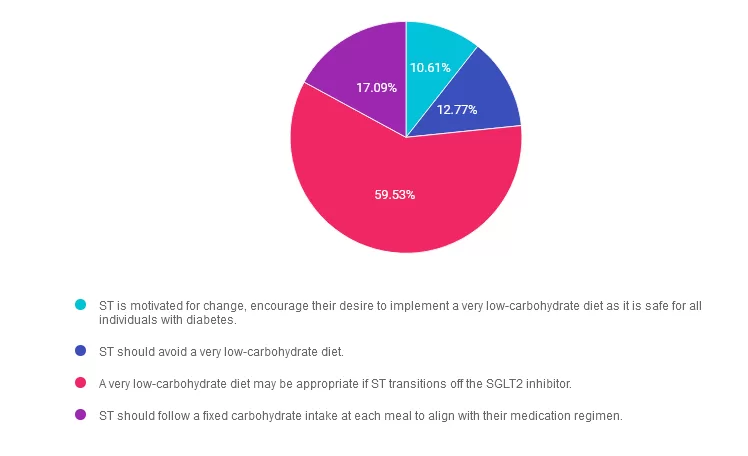
Getting to the Best Answer
Answer 1 is incorrect. 10.61% chose this answer. “ST is motivated for change, encourage their desire to implement a very low-carbohydrate diet as it is safe for all individuals with diabetes.” While very-low-carbohydrate diets has evidence for reducing A1c and need for additional medications, they may not be universally safe for all individuals. Keep reading to learn more.
Answer 2 is incorrect. 12.77% of you chose this answer. “ST should avoid a very low-carbohydrate diet.” A very-low-carbohydrate diet is not inherently contraindicated for individuals with diabetes, but careful planning and potential discontinuation of the SGLT2 inhibitor is recommended to reduce the risk of euglycemic ketoacidosis.
Answer 3 is correct. About 59.53% of respondents chose this. “A very low-carbohydrate diet may be appropriate if ST transitions off the SGLT2 inhibitor.” Use SGLT2 inhibitors with caution when implementing a low carbohydrate diet and strong consideration should be made to cease this medication if implementing a very low carbohydrate diet, less than 50 grams of carbohydrate per day. Very low carbohydrate diets may increase the risk of euglycemic ketoacidosis by lowering insulin levels. After additional clinical review, a very-low-carbohydrate diet can be considered for ST if they transition off the SGLT2 inhibitor. Educating ST about the difference between physiological ketosis and pathological ketoacidosis may also be considered.
Finally, Answer 4 is incorrect. 17.09% chose this answer. “ST should follow a fixed carbohydrate intake at each meal to align with their medication regimen.” While fixed carbohydrate intake can sometimes simplify diabetes management, it does not align with ST’s interest in very-low-carbohydrate eating patterns. The current medication regimen does not necessarily require a fixed carbohydrate plan. Simply educating on this approach without additional shared decision making may not provide an individualized dietary intervention.
Reference: American Diabetes Association Professional Practice Committee; 5. Facilitating Positive Health Behaviors and Well-being to Improve Health Outcomes: Standards of Care in Diabetes—2024. Diabetes Care 1 January 2024; 47 (Supplement_1): S77–S110. https://doi.org/10.2337/dc24-S005
We hope you appreciate this week’s rationale! Thank you so much for taking the time to answer our Question of the Week and participate in this fun learning activity!
Want to learn more about this question?
Check out these upcoming class offerings!
All hours earned count toward your CDCES Accreditation Information
Sign up for Diabetes Blog Bytes – we post weekly Blog Bytes that are informative and FREE! Every week we post one exam practice Question of the Week and Rationale of the Week. Sign up below!
Recent Blog Bytes
- Question of the Week | CS’s A1C Climbs After Experiencing Distress
- Keeping You in the Loop: twiist Insulin Pump
- Question of the Week | What Do New ADA Standards Say About Development of Type 2?
- Rationale of the Week | What Year ADA Standards Should JR Study?
- New CDCES Coach App – Download Yours Today!
The use of DES products does not guarantee the successful passage of the certification exam. CBDCE and ADCES do not endorse any preparatory or review materials for the CDCES or BC-ADM exams, except for those published by CBDCE & ADCES.
Entering the Field of Diabetes Education – Building a Bridge Program
Building a Bridge to Welcome New Diabetes Specialists
 We are geared up to help grow and mentor future diabetes specialists to meet the increasing and varied needs of our diabetes community, but we need your help.
We are geared up to help grow and mentor future diabetes specialists to meet the increasing and varied needs of our diabetes community, but we need your help.
Over the next 10 years we are “Building a Bridge” to welcome a thousand new diabetes educators into the field. If you know a healthcare professional seeking a new challenge and eager to pursue a meaningful and rewarding specialty, please invite them to consider becoming a Certified Diabetes Care and Education Specialist (CDCES).
To reach the goal of encouraging healthcare professionals to enter the field, we have created a new FREE webinar that outlines the benefits and steps involved in “Becoming a Diabetes Specialist.” We want to share this information with as many healthcare professionals as possible to encourage them to consider specializing in diabetes.
Our goal is to cast this net far and wide to address the rising prevalence of diabetes. Currently, 16% of people in the United States live with diabetes, and over 38% live with prediabetes according to the CDC. Diabetes is more prevalent in communities of color and impacts individuals with less income and resources. CDCES’s are influential in addressing health disparities and promoting equitable care through their work in health care settings across the country.
Why Become a CDCES?
On a personal note, becoming a CDCES is one of the best professional decisions I have ever made. This certification has opened the door to many opportunities and dramatically increased my job satisfaction.
Currently, there are 19,500 healthcare professionals with the CDCES credential, including registered nurses (RNs), nurse practitioners (NPs), registered dietitian nutritionists (RDNs), pharmacists, physicians, and physician assistants (PAs)es. At Diabetes Education Services, we are trying to enhance diversity within the CDCES community through our scholarship programs, to encourage a broader range of applicants to pursue certification. We are planning to offer more scholarships in the future to reach our goal of welcoming a thousand new educators into this profession.
There is more to be done, and we appreciate your help speaking to colleagues and letting them know about the benefits of becoming a CDCES. If you are part of a healthcare organization and want Coach Beverly to present the steps involved in becoming a Diabetes Specialist, we are happy to provide a virtual presentation at no cost. Please reach out to discuss details at [email protected].
Benefits of Becoming a CDCES
1. Improving Diabetes Outcomes and Quality of Life
- CDCES professionals advocate for effective diabetes management through person-centered care and education.
- Studies show that diabetes education improves glycemic management, reduces complications, and lowers hospitalization rates.
- Diabetes care specialists address the psychosocial aspects of diabetes and support problem-solving and well-being.
2. Addressing Health Disparities:
- CDCESs are essential in caring for diverse populations, including those disproportionately affected by diabetes.
- We are a part of advocating for equity and increased access to care.
3. Reducing Healthcare Costs:
- Diabetes education can significantly reduce healthcare costs by preventing complications such as heart disease, kidney failure, and lower extremity complications.
- CDCESs contribute to cost savings by promoting preventive care and self-management.
4. Expansion of Care Models:
- With a shift towards value-based care, there is a growing emphasis on preventive health services and chronic disease management, increasing demand for CDCESs in hospitals, clinics, and community health settings.
- CDCES professionals are vital in addressing the diabetes crisis in the U.S., improving both individual health outcomes and public health overall. Their expertise is increasingly in demand across various healthcare settings.
How to Become a Certified Diabetes Care and Education Specialist (CDCES)
- Educational Requirement: Hold a relevant degree such as in nursing, dietetics, pharmacy, or other health-related field.
- Professional Licensure: Maintain an active license in a qualifying health discipline (e.g., RN, RD, MD, etc.) or have a degree in an eligible field like public health or social work.
- Experience Requirement:
- A minimum of two years (to the day) of professional practice experience in the discipline under which one is applying for certification.
- Obtain at least 1,000 hours of diabetes education experience within the last five years, with at least 200 hours in the most recent year.
- Continuing Education: Complete at least 15 hours of continuing education in diabetes management and care within 2 years before applying.
- Exam Application and Preparation:
- Apply for the CDCES exam through the Certification Board for Diabetes Care and Education (CBDCE).
- Prepare using study materials, review courses, and practice exams related to diabetes education.
- Pass the CDCES Exam: Successfully pass the 175-question certification exam, which covers topics including assessment, care and education strategies, standards and practices.
- Maintain Certification: You can renew your certification every five years through continuing education, fulfilling practice hour requirements, or retaking the exam.
Visit the official CBDCE website or relevant professional bodies for more detailed guidance or recent updates.
Visit our CDCES Prep Page for more information and to register for FREE Webinars with lots of helpful information.
Building a Bridge Program: At Diabetes Education Services, our goal is to mentor the next generation of Certified Diabetes Care and Education Specialists (CDCES). We are committed to welcoming healthcare professionals with diverse experiences and backgrounds to enter the diabetes field. Our online programs and scholarship programs aim to provide emerging CDCES professionals with the knowledge, skills, and confidence to address the unique challenges encountered by people with diabetes from all walks of life, while also preparing them for certification.
Interested in becoming a CDCES but not sure where to start?
Our 2-Step FREE Webinars Series Will Guide You
Our FREE webinars will help you discover the steps required to become a CDCES and will transform your test anxiety into calm self-confidence and test-taking readiness.
- Want to learn more about the qualifications to take the CDCES exam? Register for our Free “Becoming A Diabetes Specialist” Step 1 Webinar.
- Taking the CDCES Exam in the next 6 months? Register for our Step 2, “Prep to Take the CDCES Exam” Free Webinar.
Step 1: Becoming a Diabetes Specialist (CDCES)

If you are a health care professional considering becoming a CDCES and want to learn more about eligibility and benefits of joining the Diabetes Education Community, this FREE webinar is for YOU. Coach Beverly will provide clarification on requirements, exam content, and study strategies to prepare for success.
Step 1: Webinar Topics
- Benefits of becoming a CDCES
- CDCES eligibility requirements for 2025
- Exam outline and study strategies to succeed
2025 Step 1 Webinar
Handouts
Step 2: Preapring to Take the CDCES Exam

We will review examination process, sample test questions, and the reasoning behind choosing the BEST answers. We will review examination process, sample test questions, and the reasoning behind choosing the BEST answers.
Step 2: Webinar Topics
- Test content updates for 2025
- Strategies to experience exam success
- Review of study tips and test taking practice questions
2025 Step 2 Webinar
Handouts
Can’t join us live?
Don’t worry, if you register, we will send you a link to the recorded version.
Instructor
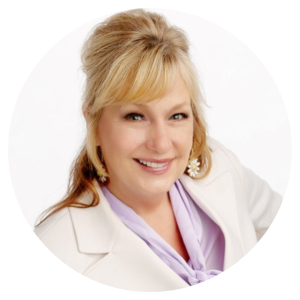
Coach Beverly Thomassian, RN, MPH, BC-ADM, CDCES
Author, Nurse, Educator, Clinician, and Innovator, Beverly has specialized in diabetes management for over twenty years and has successfully passed the CDCES exam six times. As president and founder of Diabetes Education Services, Beverly is dedicated to optimizing diabetes care and improving the lives of those with diabetes.
“Becoming a Certified Diabetes Care and Education Specialist (CDCES) is one of the best professional and personal decisions I have ever made.” – Coach Beverly Thomassian
The use of DES products does not guarantee the successful passage of the diabetes certification exams. CBDCE & ADCES does not endorse any preparatory or review materials for the certification exams, except for those published by CBDCE & ADCES.
**To satisfy the requirement for renewal of certification by continuing education for the Certification Board for Diabetes Care & Education (CBDCE), continuing education activities must be applicable to diabetes and approved by a provider on the CBDCE List of Recognized Providers (www.ncbde.org). CBDCE does not approve of continuing education. Diabetes Education Services is accredited/approved by the Commission of Dietetic Registration which is on the list of CBDCE Recognized Providers.

